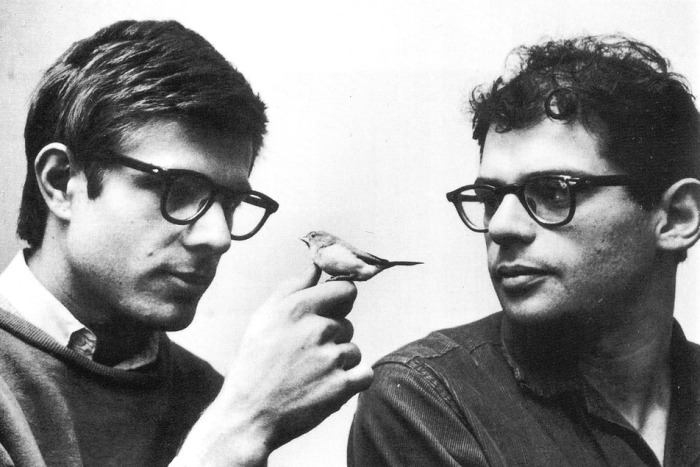 Renowned poet, radical queer, visionary, one of the founders of the Beat Generation, lecturer, Buddhist, political activist and more, Allen Ginsberg’s remarkable life shaped the very soul of American counter-culture.
Renowned poet, radical queer, visionary, one of the founders of the Beat Generation, lecturer, Buddhist, political activist and more, Allen Ginsberg’s remarkable life shaped the very soul of American counter-culture.
The Life and Times of Allen Ginsberg condenses 60 hours of film on Ginsberg, painstakingly collected over 25 years by director Jerry Aronson, into a comprehensive portrait of Ginsberg. This film was first screened at the Sundance Film Festival in 1993. Now digitally remastered and available on streaming sites, it’s time to revisit this queer icon, one of America’s greatest poets, the author of Howl and other ground-breaking poems.
Ginsberg was born in Newark, New Jersey, in 1926, to Russian immigrant parents escaping from the pogroms. His father was a high school teacher and a minor poet. His mother had severe mental health issues and was frequently hospitalized. Despite her illnesses, Ginsberg had a happy childhood and was a well-behaved, conformist Jewish boy. He went to Columbia University after the Second World War where he met Jack Kerouac, John Clellon Holmes and William Burroughs. There he opened up to Kerouac and Burroughs about his sexuality. Burroughs was gay and Kerouac, although married three times, was bisexual. Their ‘dharma bums’ friendship was chronicled by Kerouac, and the Beat literary scene was introduced by them to the world. 42nd St and Times Square were their hang-outs as the group sought to offer American youth an alternative vision (‘The New Vision”) to the post-war McCarthy-era conformist American Dream.
The close-knit Beat group grew in the 1950s as they met more like-minded souls, including writer/poet/hobos Herbert Hunke, (“The Mayor of 42nd St”) and Neal Cassady. During this time Ginsberg wrote his best work, including the very out-there Howl as well as Kaddish. Life was druggy, boozy, sex-positive, and bohemian. In 1954, Ginsberg met handsome, fellow bisexual, actor/poet Peter Orlovsky, and the pair began an over 50-year-long romance. The Korean War inspired Ginsberg’s activism in this period which saw him live in San Francisco, Tangiers and Paris.
 The 1960s saw Ginsberg develop his peace activism as he campaigned against the Vietnam War. He spent time in India, Greece, Israel, London and Kenya. He was the poster child of the hippy movement and a strong proponent of flower power, known for his kind, intelligent demeanor, anti-materialism, anti-sexual-repression, as well as his generosity. He also developed his Buddhism. One of his most influential teachers was Tibetan Buddhist Chogyam Trungpa, the founder of the Naropa Institute in Boulder, Colorado. At Trungpa’s urging, Ginsberg and poet Anne Waldwann started the Jack Kerouac School of Disembodied Poetics there in 1974. His Buddhism and political activism continued, along with a new vocation as a teacher, through the next few decades, to his death in 1998.
The 1960s saw Ginsberg develop his peace activism as he campaigned against the Vietnam War. He spent time in India, Greece, Israel, London and Kenya. He was the poster child of the hippy movement and a strong proponent of flower power, known for his kind, intelligent demeanor, anti-materialism, anti-sexual-repression, as well as his generosity. He also developed his Buddhism. One of his most influential teachers was Tibetan Buddhist Chogyam Trungpa, the founder of the Naropa Institute in Boulder, Colorado. At Trungpa’s urging, Ginsberg and poet Anne Waldwann started the Jack Kerouac School of Disembodied Poetics there in 1974. His Buddhism and political activism continued, along with a new vocation as a teacher, through the next few decades, to his death in 1998.
Aaronson’s documentary is a must-see for all Ginsberg fans, new and old. As well as his talent, Ginsberg’s was an unapologetically queer life, lived during a time when being out and gay wasn’t easy. The film is a veritable time capsule of American culture with contributions from many outstanding luminaries including William Burroughs, Joan Baez, Norman Mailer, Ken Kesey, Timothy Leary and Abbie Hoffman. Ginsberg also contributes a lot, his contributions invariably as charged poetry readings. Archive footage and imagery include interesting interviews between Ginsberg and both Burroughs and William Buckley. A fascinating piece of social history. Highly recommended.
Tune in, Turn on, Drop out.
Queerguru’s Contributing Editor Ris Fatah is a successful fashion/luxury business consultant (when he can be bothered) who divides and wastes his time between London and Ibiza. He is a lover of all things queer, feminist, and human rights in general. @ris.fatah

